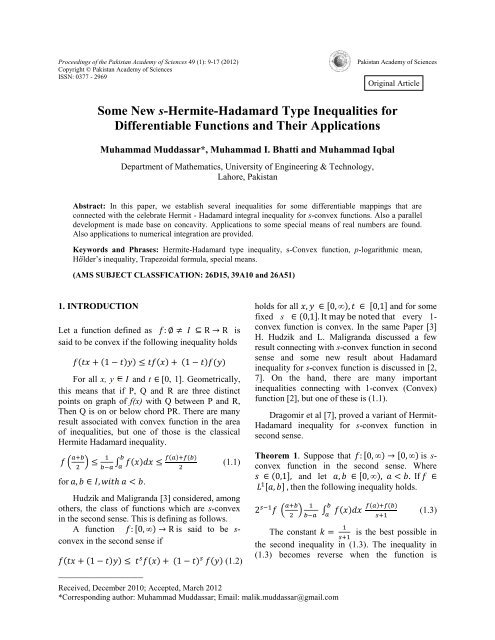TITLE MARCH 2012 - Pakistan Academy of Sciences
TITLE MARCH 2012 - Pakistan Academy of Sciences
TITLE MARCH 2012 - Pakistan Academy of Sciences
Create successful ePaper yourself
Turn your PDF publications into a flip-book with our unique Google optimized e-Paper software.
Proceedings <strong>of</strong> the <strong>Pakistan</strong> <strong>Academy</strong> <strong>of</strong> <strong>Sciences</strong> 49 (1): 9-17 (<strong>2012</strong>)<br />
Copyright © <strong>Pakistan</strong> <strong>Academy</strong> <strong>of</strong> <strong>Sciences</strong><br />
ISSN: 0377 - 2969<br />
<strong>Pakistan</strong> <strong>Academy</strong> <strong>of</strong> <strong>Sciences</strong><br />
Original Article<br />
Some New s-Hermite-Hadamard Type Inequalities for<br />
Differentiable Functions and Their Applications<br />
Muhammad Muddassar*, Muhammad I. Bhatti and Muhammad Iqbal<br />
Department <strong>of</strong> Mathematics, University <strong>of</strong> Engineering & Technology,<br />
Lahore, <strong>Pakistan</strong><br />
Abstract: In this paper, we establish several inequalities for some differentiable mappings that are<br />
connected with the celebrate Hermit - Hadamard integral inequality for s-convex functions. Also a parallel<br />
development is made base on concavity. Applications to some special means <strong>of</strong> real numbers are found.<br />
Also applications to numerical integration are provided.<br />
Keywords and Phrases: Hermite-Hadamard type inequality, s-Convex function, p-logarithmic mean,<br />
H lder’s inequality, Trapezoidal formula, special means.<br />
(AMS SUBJECT CLASSFICATION: 26D15, 39A10 and 26A51)<br />
1. INTRODUCTION<br />
Let a function defined as<br />
is<br />
said to be convex if the following inequality holds<br />
For all x, y and t [0, 1]. Geometrically,<br />
this means that if P, Q and R are three distinct<br />
points on graph <strong>of</strong> f(x) with Q between P and R,<br />
Then Q is on or below chord PR. There are many<br />
result associated with convex function in the area<br />
<strong>of</strong> inequalities, but one <strong>of</strong> those is the classical<br />
Hermite Hadamard inequality.<br />
for .<br />
(1.1)<br />
Hudzik and Maligranda [3] considered, among<br />
others, the class <strong>of</strong> functions which are s-convex<br />
in the second sense. This is defining as follows.<br />
A function is said to be s-<br />
convex in the second sense if<br />
_____________________<br />
(1.2)<br />
Received, December 2010; Accepted, March <strong>2012</strong><br />
*Corresponding author: Muhammad Muddassar; Email: malik.muddassar@gmail.com<br />
holds for all<br />
and for some<br />
fixed s that every 1-<br />
convex function is convex. In the same Paper [3]<br />
H. Hudzik and L. Maligranda discussed a few<br />
result connecting with s-convex function in second<br />
sense and some new result about Hadamard<br />
inequality for s-convex function is discussed in [2,<br />
7]. On the hand, there are many important<br />
inequalities connecting with 1-convex (Convex)<br />
function [2], but one <strong>of</strong> these is (1.1).<br />
Dragomir et al [7], proved a variant <strong>of</strong> Hermit-<br />
Hadamard inequality for s-convex function in<br />
second sense.<br />
Theorem 1. Suppose that is s-<br />
convex function in the second sense. Where<br />
and let<br />
then the following inequality holds.<br />
(1.3)<br />
The constant is the best possible in<br />
the second inequality in (1.3). The inequality in<br />
(1.3) becomes reverse when the function is

















